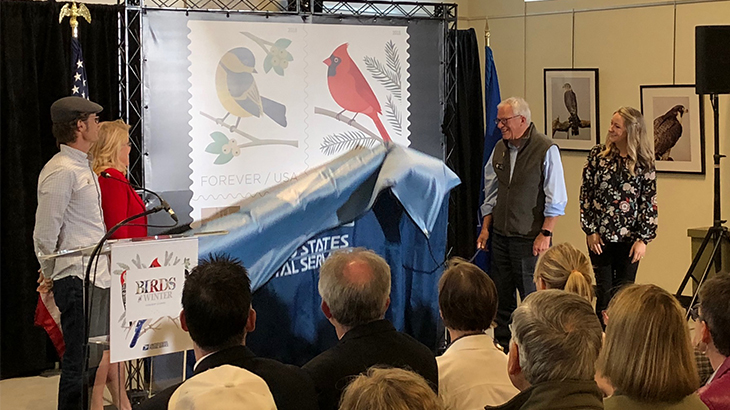US Stamps
Winter birds take off at FDOI ceremony in Vermont

By Molly Goad
The Vermont Institute of Natural Science hosted a first-day of issue ceremony for the United States Birds in Winter forever stamps Sept. 22.
VINS is located in Quechee, Vt., and offers environmental education and avian rehabilitation programs. Executive director Charles Rattigan welcomed the crowd of more than 100 people.
“At VINS, we are in the business of environmental education,” he said. “We’re working very hard to help create the next generation of environmental stewards, and you’re all part of that process. We appreciate you coming today to experience this … we are delighted and we think the stamps are so particularly beautiful.”
Four of winter’s feathered friends appear on the set: the black-capped chickadee, the northern cardinal, the blue jay and the red-bellied woodpecker. The stamps were designed by Antonio Alcalá from original artwork by Nadia Taylor.
Postal Service Pricing and Costing Vice President Sharon D. Owens served as the dedicating official.
“The stylized images highlight the colorful feathers of these resilient birds against a stark white background,” Owens said. “A limited palette and the simplified shapes give the birds a bold, fresh look.”
Ornithologist and quantitative ecologist Jason Hill also took to the podium, offering five simple ways to help conserve bird populations, including the four species featured on the stamps — the species that many grew up with in their back yards.
First, Hill said, financial support is needed; there are numerous crowd sourcing websites accepting donations in this area, such as experiment.com.
Hill also emphasized purchasing a migratory bird hunting and conservation stamp annually, citing that 98 percent of the purchase price goes to conservation efforts for migratory bird populations and their habitat.
Connect with Linn’s Stamp News:
Sign up for our newsletter
Like us on Facebook
Follow us on Twitter
At home, Hill recommended reducing the extent of your lawn, eliminating pesticides and growing native plants that provide food and a year-round habitat for bird populations.
Also, support agriculture producers who grow coffee in a way that promotes bird populations. According to the Smithsonian’s National Zoo & Conservation Biology Institute, “Bird Friendly certified organic coffees grow under biodiverse shade that provides critical habitat for migratory songbirds and other wildlife, sequesters carbon and fights climate change.” Hill suggested visiting the Smithsonian’s webpage to learn more, and ask your local coffee shop to carry one Bird Friendly certified organic coffee.
Finally, Hill said it’s very important to pass this passion on to our children, proposing gifts of old binoculars, a field guide and hiking shoes instead of traditional presents.
“As the father of a two-year-old child, I believe we have a responsibility to preserve what we have for future generations to experience,” he said.
The ceremony included a presentation of colors by Wilder Boy Scout Troop 260 and the National Anthem performed by the Hartford High School concert choir.
After the dedication, VINS provided a demonstration with live birds and an owl.
MORE RELATED ARTICLES
Headlines
-
US Stamps
Oct 7, 2024, 3 PMMcMurtrie dismissed as APS education director following Sept. 21 arrest
-
US Stamps
Oct 7, 2024, 12 PMVasiliauskas named president of Mystic Stamp Co.
-
US Stamps
Oct 6, 2024, 5 PMApgar souvenir card available
-
US Stamps
Oct 6, 2024, 4 PMFirst Continental Congress and U.N. stamps receive Scott catalog numbers








